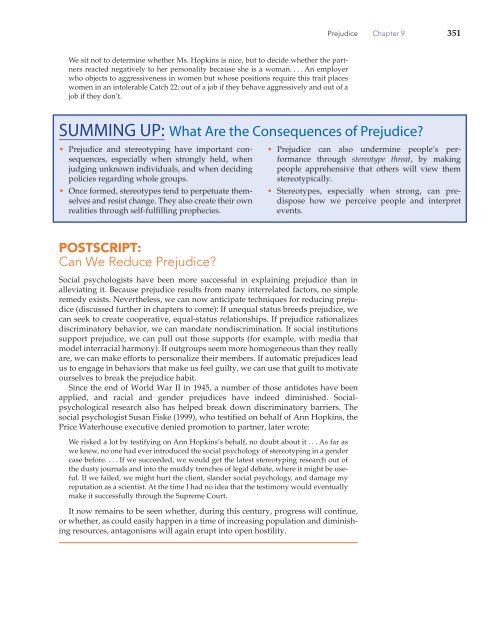Chapter 9: Prejudice: Disliking Others (2947.0K) - Bad Request
Chapter 9: Prejudice: Disliking Others (2947.0K) - Bad Request
Chapter 9: Prejudice: Disliking Others (2947.0K) - Bad Request
You also want an ePaper? Increase the reach of your titles
YUMPU automatically turns print PDFs into web optimized ePapers that Google loves.
We sit not to determine whether Ms. Hopkins is nice, but to decide whether the partners<br />
reacted negatively to her personality because she is a woman. . . . An employer<br />
who objects to aggressiveness in women but whose positions require this trait places<br />
women in an intolerable Catch 22: out of a job if they behave aggressively and out of a<br />
job if they don’t.<br />
SUMMING UP:<br />
• <strong>Prejudice</strong> and stereotyping have important consequences,<br />
especially when strongly held, when<br />
judging unknown individuals, and when deciding<br />
policies regarding whole groups.<br />
• Once formed, stereotypes tend to perpetuate themselves<br />
and resist change. They also create their own<br />
realities through self-fulfilling prophecies.<br />
POSTSCRIPT:<br />
Can We Reduce <strong>Prejudice</strong>?<br />
<strong>Prejudice</strong> <strong>Chapter</strong> 9 351<br />
What Are the Consequences of <strong>Prejudice</strong>?<br />
Social psychologists have been more successful in explaining prejudice than in<br />
alleviating it. Because prejudice results from many interrelated factors, no simple<br />
remedy exists. Nevertheless, we can now anticipate techniques for reducing prejudice<br />
(discussed further in chapters to come): If unequal status breeds prejudice, we<br />
can seek to create cooperative, equal-status relationships. If prejudice rationalizes<br />
discriminatory behavior, we can mandate nondiscrimination. If social institutions<br />
support prejudice, we can pull out those supports (for example, with media that<br />
model interracial harmony). If outgroups seem more homogeneous than they really<br />
are, we can make efforts to personalize their members. If automatic prejudices lead<br />
us to engage in behaviors that make us feel guilty, we can use that guilt to motivate<br />
ourselves to break the prejudice habit.<br />
Since the end of World War II in 1945, a number of those antidotes have been<br />
applied, and racial and gender prejudices have indeed diminished. Social-<br />
psychological research also has helped break down discriminatory barriers. The<br />
social psychologist Susan Fiske (1999), who testified on behalf of Ann Hopkins, the<br />
Price Waterhouse executive denied promotion to partner, later wrote:<br />
We risked a lot by testifying on Ann Hopkins’s behalf, no doubt about it . . . As far as<br />
we knew, no one had ever introduced the social psychology of stereotyping in a gender<br />
case before. . . . If we succeeded, we would get the latest stereotyping research out of<br />
the dusty journals and into the muddy trenches of legal debate, where it might be useful.<br />
If we failed, we might hurt the client, slander social psychology, and damage my<br />
reputation as a scientist. At the time I had no idea that the testimony would eventually<br />
make it successfully through the Supreme Court.<br />
It now remains to be seen whether, during this century, progress will continue,<br />
or whether, as could easily happen in a time of increasing population and diminishing<br />
resources, antagonisms will again erupt into open hostility.<br />
• <strong>Prejudice</strong> can also undermine people’s performance<br />
through stereotype threat , by making<br />
people apprehensive that others will view them<br />
stereotypically.<br />
• Stereotypes, especially when strong, can predispose<br />
how we perceive people and interpret<br />
events.

















